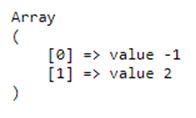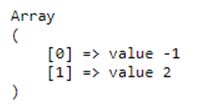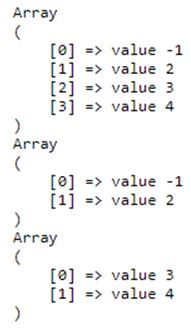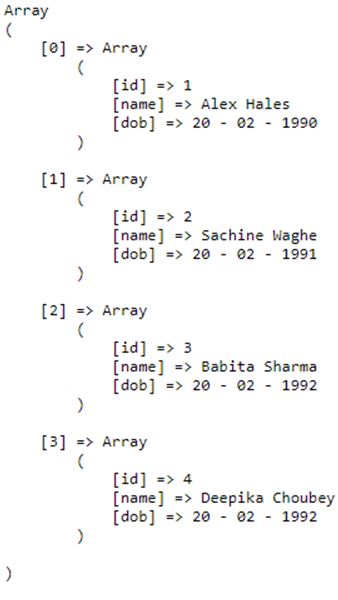PHP Split Array
Dealing with the arrays and the array related operations are very common in the PHP Programming Language, a split array is one of them. PHP itself has various built-in functions to handle this. A developer or the coder can do the same by writing their own custom code. Split is all about converting a single array into multiple arrays. An array can be split into the number of chunks. A built-in function array_chunk() can be used to split the array into multiple arrays with a defined number of elements.
ADVERTISEMENT Popular Course in this category PHP DEVELOPER - Specialization | 8 Course Series | 3 Mock TestsStart Your Free Software Development Course
Web development, programming languages, Software testing & others
Syntax:
1. array_chunk()
array_chunk(array, size, preserve_key)
- array_chunk() is the function itself.
- The array and size are the required parameters.
- preserve_key takes the boolean value.
2. array_slice()
array_slice(array, start, length, preserve)
- array_slice() is the function itself.
- The array and the start are the required parameters.
- Length and the preserve are the optional parameters. The start parameter shows from which position the array needs to slice and the length is to what length.
The output of array_chunk(directly assigned to the multiple arrays):
list($array1, $array2,.....) = array_chunk($array, length);
$array1, $array2…. are the array in which the array element will be assigned after the split from the $array. A developer or the code should be careful about the number of elements and the size of the array in which the elements need to be assigned.
How PHP Split Array work?
Given below shows how PHP Split Array works:
1. Use of array_chunk()
Before playing with the split functionality with the array there should be an array with some elements on that. Then we can apply the array_chunk() function to perform the array split related operations. This function is useful when we are required to split an array into the number of defined elements. Using array_chunk() function, the output can be stored into a single array and the other hand the output can be stored on the multiple arrays as well.
2. Use of array_slice()
It is another way of splitting an array, in this we can get the number of specific elements from an array.
3. Use of str_split()
A string can split into the array by using the str_split() function. This function can change each character of that string into an array.
Example:
Code:
$string = "Hello India"; print_r(str_split($string));
Examples of PHP Split Array
Given below are the examples mentioned:
Example #1
Split an array in the chunk of 2 elements and print the first segment of the new array.
Code:
<?php
$array = array('value -1', 'value 2', 'value 3', 'value 4', 'value 5','value -6','value -7');
$newArrays = array_chunk($array,2); // apply array chunk
echo "<pre class="brush:php;toolbar:false">";
print_r($newArrays[0]); // print the first segment (position) array after splitting that array.
?>Output:

Example #2
Let’s try to get to achieve the same using the array_slice() as Ex1.
Code:
<?php
$array = array('value -1', 'value 2', 'value 3', 'value 4', 'value 5','value -6','value -7');
$newArrays = array_slice($array,0,2); // apply slicing from 0 position with the length of 2
echo "<pre class="brush:php;toolbar:false">";
print_r($newArrays);
?>We can see the same output here as we see in example 1.
Output:

Example #3
Let’s try to split the array and assigned to predefined array.
Code:
<?php
$array = array('value -1', 'value 2', 'value 3', 'value 4');
echo "<pre class="brush:php;toolbar:false">";
print_r($array); // print the first segment (position) array after splitting that array.
list($array1, $array2) = array_chunk($array, 2);
print_r($array1);
print_r($array2);
?>Output:

In the output area we can see the three arrays. First one is the actual array, 2nd and the 3rd array is the part of the actual array after splitting.
Code:
list($array1, $array2) = array_chunk($array, 2);
In other words after the split, both arrays will be assigned automatically to $array1 and $array2 respectively.
Example #4
Use of array_chunk() with the multi-dimensional array.
Code:
<?php
$employees = array(
array("id" => 1,
"name" => "Alex Hales",
"dob" => "20 - 02 - 1990" ),
array("id" => 2,
"name" => "SachineWaghe",
"dob" => "20 - 02 - 1991" ),
array("id" => 3,
"name" => "Babita Sharma",
"dob" => "20 - 02 - 1992" ),
array("id" => 4,
"name" => "DeepikaChoubey",
"dob" => "20 - 02 - 1992" )
);
echo "<pre class="brush:php;toolbar:false">";
print_r($employees); // actual array
$employeesArra = array_chunk($employees, 2); // array after split
print_r($employeesArra);
?>Output:



Conclusion
There are various ways we can process the split array. While using the array_chunk() with the dynamic array assignment the developer should be careful enough, because sometimes the array and the size can break the system functionality. The array_chunk() function can be used with the single array and the associate array as well. This function can be used on all types of array.
The above is the detailed content of PHP Split Array. For more information, please follow other related articles on the PHP Chinese website!

Hot AI Tools

Undresser.AI Undress
AI-powered app for creating realistic nude photos

AI Clothes Remover
Online AI tool for removing clothes from photos.

Undress AI Tool
Undress images for free

Clothoff.io
AI clothes remover

Video Face Swap
Swap faces in any video effortlessly with our completely free AI face swap tool!

Hot Article

Hot Tools

Notepad++7.3.1
Easy-to-use and free code editor

SublimeText3 Chinese version
Chinese version, very easy to use

Zend Studio 13.0.1
Powerful PHP integrated development environment

Dreamweaver CS6
Visual web development tools

SublimeText3 Mac version
God-level code editing software (SublimeText3)

Hot Topics
 PHP 8.4 Installation and Upgrade guide for Ubuntu and Debian
Dec 24, 2024 pm 04:42 PM
PHP 8.4 Installation and Upgrade guide for Ubuntu and Debian
Dec 24, 2024 pm 04:42 PM
PHP 8.4 brings several new features, security improvements, and performance improvements with healthy amounts of feature deprecations and removals. This guide explains how to install PHP 8.4 or upgrade to PHP 8.4 on Ubuntu, Debian, or their derivati
 How To Set Up Visual Studio Code (VS Code) for PHP Development
Dec 20, 2024 am 11:31 AM
How To Set Up Visual Studio Code (VS Code) for PHP Development
Dec 20, 2024 am 11:31 AM
Visual Studio Code, also known as VS Code, is a free source code editor — or integrated development environment (IDE) — available for all major operating systems. With a large collection of extensions for many programming languages, VS Code can be c
 Explain JSON Web Tokens (JWT) and their use case in PHP APIs.
Apr 05, 2025 am 12:04 AM
Explain JSON Web Tokens (JWT) and their use case in PHP APIs.
Apr 05, 2025 am 12:04 AM
JWT is an open standard based on JSON, used to securely transmit information between parties, mainly for identity authentication and information exchange. 1. JWT consists of three parts: Header, Payload and Signature. 2. The working principle of JWT includes three steps: generating JWT, verifying JWT and parsing Payload. 3. When using JWT for authentication in PHP, JWT can be generated and verified, and user role and permission information can be included in advanced usage. 4. Common errors include signature verification failure, token expiration, and payload oversized. Debugging skills include using debugging tools and logging. 5. Performance optimization and best practices include using appropriate signature algorithms, setting validity periods reasonably,
 PHP Program to Count Vowels in a String
Feb 07, 2025 pm 12:12 PM
PHP Program to Count Vowels in a String
Feb 07, 2025 pm 12:12 PM
A string is a sequence of characters, including letters, numbers, and symbols. This tutorial will learn how to calculate the number of vowels in a given string in PHP using different methods. The vowels in English are a, e, i, o, u, and they can be uppercase or lowercase. What is a vowel? Vowels are alphabetic characters that represent a specific pronunciation. There are five vowels in English, including uppercase and lowercase: a, e, i, o, u Example 1 Input: String = "Tutorialspoint" Output: 6 explain The vowels in the string "Tutorialspoint" are u, o, i, a, o, i. There are 6 yuan in total
 How do you parse and process HTML/XML in PHP?
Feb 07, 2025 am 11:57 AM
How do you parse and process HTML/XML in PHP?
Feb 07, 2025 am 11:57 AM
This tutorial demonstrates how to efficiently process XML documents using PHP. XML (eXtensible Markup Language) is a versatile text-based markup language designed for both human readability and machine parsing. It's commonly used for data storage an
 Explain late static binding in PHP (static::).
Apr 03, 2025 am 12:04 AM
Explain late static binding in PHP (static::).
Apr 03, 2025 am 12:04 AM
Static binding (static::) implements late static binding (LSB) in PHP, allowing calling classes to be referenced in static contexts rather than defining classes. 1) The parsing process is performed at runtime, 2) Look up the call class in the inheritance relationship, 3) It may bring performance overhead.
 What are PHP magic methods (__construct, __destruct, __call, __get, __set, etc.) and provide use cases?
Apr 03, 2025 am 12:03 AM
What are PHP magic methods (__construct, __destruct, __call, __get, __set, etc.) and provide use cases?
Apr 03, 2025 am 12:03 AM
What are the magic methods of PHP? PHP's magic methods include: 1.\_\_construct, used to initialize objects; 2.\_\_destruct, used to clean up resources; 3.\_\_call, handle non-existent method calls; 4.\_\_get, implement dynamic attribute access; 5.\_\_set, implement dynamic attribute settings. These methods are automatically called in certain situations, improving code flexibility and efficiency.
 PHP and Python: Comparing Two Popular Programming Languages
Apr 14, 2025 am 12:13 AM
PHP and Python: Comparing Two Popular Programming Languages
Apr 14, 2025 am 12:13 AM
PHP and Python each have their own advantages, and choose according to project requirements. 1.PHP is suitable for web development, especially for rapid development and maintenance of websites. 2. Python is suitable for data science, machine learning and artificial intelligence, with concise syntax and suitable for beginners.






